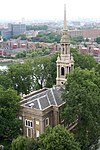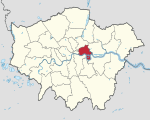Bishop Challoner Catholic Collegiate School
Bishop Challoner Catholic Federation of Schools is a Roman Catholic secondary school and sixth form, located in the Shadwell area of the London Borough of Tower Hamlets, England. In May 2015, the name of the schools formally changed from "the Collegiate" to its current nomenclature of Bishop Challoner Catholic Federation of Schools. The school is a voluntary aided federation of a boys' school, a girls' school and a co-educational sixth form. The school is administered by Tower Hamlets London Borough Council and the Roman Catholic Archdiocese of Westminster. In 2016, around 50% of the intake was Roman Catholic. Whilst the pupil profile at Bishop Challoner is diverse, Bangladeshi children are very significantly under-represented in comparison to Tower Hamlets as a whole and the schools receive few applications from Bangladeshi parents. Nevertheless, in 1992, local parents unsuccessfully challenged the admission policy to Bishop Challoner RC Girls' School in the House of Lords (R v Governors of the Bishop Challoner Roman Catholic Comprehensive Girls' School ex parte Choudhury and Purkayastha). Tower Hamlets Borough’s high levels of child poverty are evident in the high proportion of children entitled to free school meals which in 2011 stood at 57%.
Excerpt from the Wikipedia article Bishop Challoner Catholic Collegiate School (License: CC BY-SA 3.0, Authors).Bishop Challoner Catholic Collegiate School
Commercial Road, London Stepney
Geographical coordinates (GPS) Address Website Nearby Places Show on map
Geographical coordinates (GPS)
| Latitude | Longitude |
|---|---|
| N 51.51312 ° | E -0.051465 ° |
Address
Bishop Challoner Catholic Federation of Schools (Bishop Challoner Girls' School)
Commercial Road 352
E1 0LB London, Stepney
England, United Kingdom
Open on Google Maps







